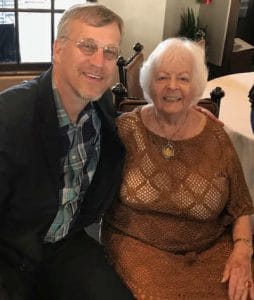
IN MEMORIAM:
NORMA KERSHAW ז״ל (1924 – 2020)
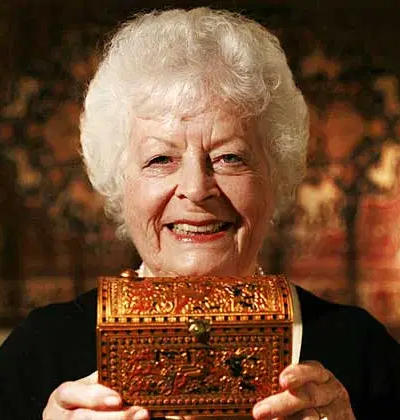
Photo courtesy of the Bowers Museum
ASOR mourns the passing of long-time member and trustee, Norma Kershaw, ז״ל (1924 – 2020), who passed away peacefully at her home in Mission Viejo, CA on September 14, at age 95. We share our condolences with Norma’s two daughters (Barbara Tiferet Rosenthal and Janet Kershaw McClennan), her son-in-law (Jeffrey Rosenthal), her four grandchildren, and her two great grandchildren.
Norma was born in New York City on New Year’s Eve in 1924. After helping her husband Reuben grow his real estate development business in Great Neck, and after rearing their children (Barbara and Janet), she went back to school. She completed the B.A. degree (Phi Beta Kappa) in anthropology and art history at Queens College in 1972. Two years later, she earned the M.A. degree in art history and archaeology from Columbia University.
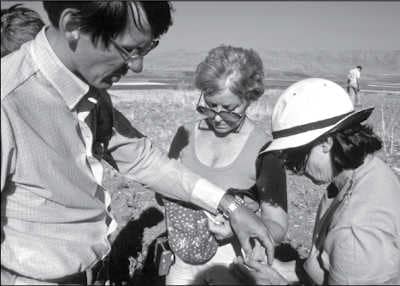
Jim Sauer, Norma Kershaw, and Joan Scheuer visiting Tell Qarqar, Syria
Norma was an ASOR member for more than 50 years, and a trustee or honorary trustee for 40 years. She began excavating in 1971 at Gezer in Israel, and she also participated in excavations at Aphek (Israel) and Salamis (Cyprus). She was elected to the ASOR Board of Trustees in 1979, and was elected an Honorary Trustee in 1988. She was the founding President of CAARI—The Cyprus American Archaeological Research Institute, and she later served as its Treasurer. Among leadership positions in ASOR, she served as chair of ASOR Tours, and later as chair of ASOR Outreach and Lectures. She was passionate and well-loved teacher of archaeology and the ancient world, and she converted many of the students in her classes into supporters of archaeology and archaeological societies. She was the recipient of ASOR’s most prestigious award—The Richard Jonas Scheuer Medal. Not only was Norma a learned scholar and teacher, but she and Reuben were generous supporters of archaeological societies and academic institutions. She was the primary supporter of News@ASOR since its inception.
While we will miss Norma dearly, we remember and celebrate her life and many accomplishments. We have included three remembrances below: a detailed and complete remembrance by Thomas Levy, and two additional remembrances by William Schniedewind, and Andrew Vaughn.
Remembering Norma Kershaw ז״ל (1924 – 2020)
Thomas E. Levy, Distinguished Professor and Norma Kershaw Chair in the Archaeology of Ancient Israel and Neighboring Lands, University of California San Diego.
Norma loved the archaeology of Israel and the Middle East and she expressed this through a life-time of study, teaching, service and philanthropy. In Norma’s adult life journey, she was supported by her loving husband Rueben, known affectionately as Rube.
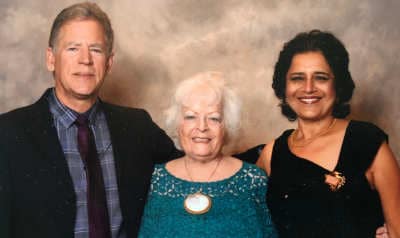
Tom and Alina Levy with Norma Kershaw
They were married in 1951 and celebrated their 61st anniversary before Rube passed away. After raising their children Barbara and Janet, in Great Neck, NY, Norma decided at the age of 43, to pursue her dreams of higher education. In an interview with the LA Times in 1996 Norma said that Rube asked, “Why do you want to go to school? You’re doing fine.”
And she said it was true—“I had a lot of friends; I was on the New York state higher education committee; I was active in the League of Women Voters; I was legislative chair for the school district. Things were OK, but I told [Rube], ‘I just have to do this. I feel very incomplete.’ I wanted to go when I was younger, but we didn’t have the money.” Norma went on to Queens College for her B.A. degree and graduated Phi Beta Kappa and then earned a Master’s degree in Archaeology and Art History from Columbia University, where she studied with the eminent art historian and archaeologist Edith Porada, graduating at the age of 49.
In 1970 while working on her B.A. degree, Norma met archaeologist William G. Dever at that American Institute of Archaeology (AIA) annual meetings that took place in Cincinnati, Ohio. Dever would go on to become one of the most prominent Biblical Archaeologists. At the time, Dever was working with the great American archaeologist, Nelson Glueck, at the Hebrew Union College excavations at the famous Biblical site of Tel Gezer in Israel. Dever insisted that if Norma was serious about archaeology, she should join the expedition and ‘get her hands dirty’ exposing the past. The following summer of 1971, Norma traveled to Israel and joined the excavation.
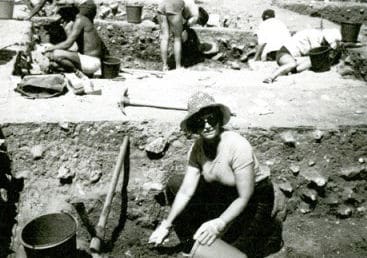
Norma at Tel Aphek, 1975
It was at Tel Gezer that summer, when I was 17 years old, that I had the good fortune to meet Norma down in the trenches. I was impressed that an “older woman”, in her early 40s was doing archaeology. Norma went on to join other excavations in Israel, Cyprus and Egypt, traveling extensively around the world, and often bringing her daughters to experience the excitement of archaeology and the world’s best museums. In the early 1980s, when I served as the Assistant Director of the W.F. Albright Institute of Archaeological Research in Jerusalem, Norma made one of her many visits to Israel and the Albright Institute. Norma loved the ‘Albright’ because of its unique mission and ability to bring together Israeli and researchers working in the Palestinian territories and neighboring Arab lands together in dialogue.
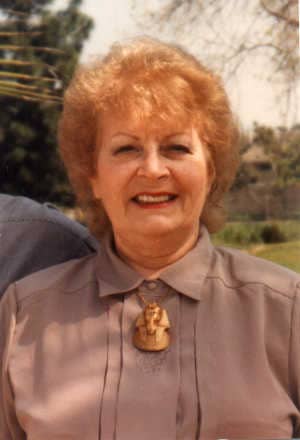
In 1990, Rube and Norma retired to Mission Viejo, California, to be closer to their daughters and grandchildren. Norma accelerated her archaeological and museum service in SoCal, becoming a founding member and devoted supporter of the American Research Center in Egypt, Orange County (ARCE-OC) and a member of the Board of Directors of the Bowers Museum in Santa Ana. In 2007, the museum named their new 300-seat auditorium the Norma Kershaw Auditorium. Norma loved to attend lectures there and always took studious notes on how each speaker could improve their future presentations. Following their lecture, Norma would button-hole the distinguished speaker and explain how they could reach the public more effectively. These suggestions were made not as a critic, but rather as a partner.
Norma was a devoted member of ASOR because it is the oldest, most distinguished and flagship organization for archaeological researchers from the United States and Canada working in the Middle East. Norma gave generously to the Albright Institute in east Jerusalem, where she became an honorary trustee. There is a garden in the back of the Albright Institute that bears her name and provides sanctuary for scholars from all religions and backgrounds meeting in the Holy City. Love for the archaeology of the island of Cyprus led Norma to become a 1978 founder and first president of CAARI—the Cyprus American Archaeological Research Center in Nicosia. She was elected as an ASOR Trustee in 1979, and she became an honorary trustee of ASOR in 1988, earning the Richard J. Scheuer Medal in 1997 and the Charles U. Harris Service Award in 2014.
When Norma and Rube first moved to Southern California, they thought about purchasing a palatial home near a golf course. However, as Norma reflected some years later, they decided they didn’t need a big house. Instead, they would rather use much of their wealth to support the institutions named above and local universities. It is in this context that I reconnected with Norma, and she and the Kershaw family became very close to my wife Alina and me, as they attended events at UC San Diego.
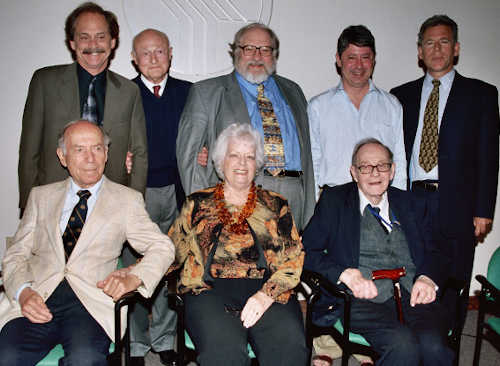
Sitting: Reuben and Norma Kershaw, D. N. Freedman Top: R. Friedman, J. Katzin, L. Stager, B. Halpern, T. Levy
In January of 2006, the UC San Diego Judaic (now Jewish) Studies Program (JSP) hosted an impressive evening around the topic of the Hebrew Bible and Archaeology at the campus Faculty Club for the JSP Board of Visitors, faculty and graduate students. Norma and Rube traveled down from Orange County to attend the celebratory event marking several decades since the founding of the program. Former University of California President and Former UC San Diego Chancellor Richard Atkinson welcomed the guests; the moderator was Jerome Katzin, an important philanthropist to our university, a founder of JSP, and an old Great Neck friend of Norma. At this time, JSP focused on the Hebrew Bible and Archaeology and our program was considered one of the finest in the United States. The faculty included Hebrew Bible scholars Professors David Noel Freedman ז״ל, Richard (Dick) Elliott Friedman, William H.C. Propp, Second Temple Period scholar David Goodblatt ז״ל, and me—Levantine and Biblical archaeology. Norma knew and highly respected Noel Freedman who she had meet when he served as Director of the Albright Institute in 1976–1977. Archaeology and Biblical Studies were the topics dearest to Norma, and by the end of the evening, she approached Dick. Later that evening, he called me at home to say, “Norma wants to endow a Chair for you.” I had to ask Dick to repeat this incredible news three times.
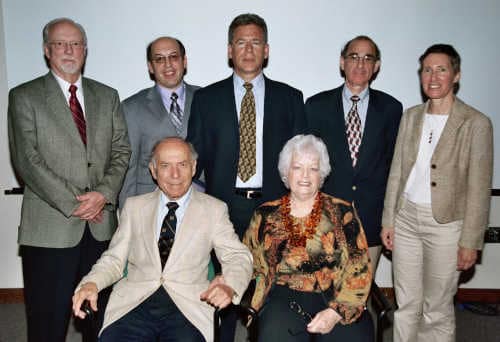
Top: W. Dever, W. Propp, T. Levy, D. Goodblatt, J. Magness
Sitting: Reuben and Norma Kershaw
Later that year, in the spring quarter, the Jewish Studies Program hosted a public event to celebrate the inauguration of the UC San Diego Norma Kershaw Chair in the Archaeology of Ancient Israel and Neighboring Lands at the university’s beautiful Institute of the Americas with a symposium on Biblical Archaeology. Over 250 people attended the event that included lectures by leading scholars including William G. Dever, David Noel Freedman ז״ל, Richard Elliott Friedman, William Propp, David Goodblatt ז״ל, Jodi Magness, Lawrence Stager ז״ל, Ron Hendel, and Baruch Halpern. Norma played an important part in organizing the event, the program, table layout, menu, and protocols, even insisting on having a team of belly-dancers. It was important for her to use an event such as the establishment of the Chair to build positive relationships between scholars, the administration, and the public to strengthen archaeology in American society.
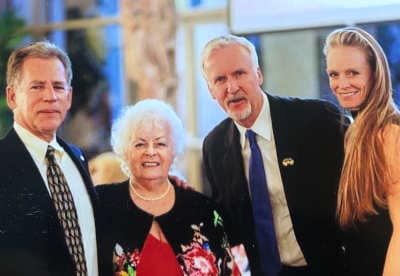
Tom Levy, Norma Kershaw, James Cameron, and Suzy Amis
Following the conference, I was privileged to edit a book to honor Norma entitled Historical Biblical Archaeology and the Future—The New Pragmatism (Equinox, UK) that included papers by the speakers and more friends, colleagues, and students including: Shlomo Bunimovitz, Avraham Faust, David Ilan, Aaron Burke, Miroslav Barta, Aaron Brody, Assaf Yasur-Landau, Ann Killebrew, Eveline van der Steen, Daniel Frese, Tara Carter, William Schniedewind, Aren Meir and Alex Joffe. Around the same time that Norma established the Norma Kershaw Chair at UC San Diego, she also generously endowed a chair at UCLA, where Hebrew Bible scholar William Schniedewind became the inaugural holder of the Kershaw Chair of Ancient Mediterranean Studies. Today, this chair is held by UCLA archaeologist Aaron Burke. Thanks to the Norma Kershaw Chair at UC San Diego and its research mission, my students, colleagues and I have been able to carry out field work in Israel, Jordan, Cyprus, Greece, Saudi Arabia, Morocco, and India, all leading to a variety of published works. Norma took great pleasure in lending a hand to these expeditions and was always excited to hear about the results of the latest project when we returned from the field.
Norma and Rube Kershaw were part of what Tom Brokaw calls ‘The Greatest Generation;’ people who grew up in the Depression. Rube was part of the American forces who fought the Nazis in North Africa during World War II. As a Jewish family who prospered in post-war United States, the Kershaw’s deeply believed in the American university system and professional institutions and wanted to contribute to strengthening them for the future. As the ASOR community and the UC San Diego Jewish Studies Program reflects on Norma’s unique contribution to the study of Levantine archaeology in the United States, we can only hope that the UC San Diego will live up to Norma’s gift and fill the Norma Kershaw Chair in the Archaeology of Ancient Israel and Neighboring Lands with a new archaeology hire when the current holder of this esteemed position retires. To Norma’s family – May the Omnipresent comfort you among the rest of the mourners of Zion and Jerusalem –
המקום ינחם אתכם בתוך שאר אבלי ציון וירושלים
William M. Schniedewind, Professor of Biblical Studies & NWS Languages, Inaugural Kershaw Chair in Ancient Mediterranean Studies, Director of Graduate & Undergraduate Studies, Near Eastern Languages & Cultures Department, UCLA.
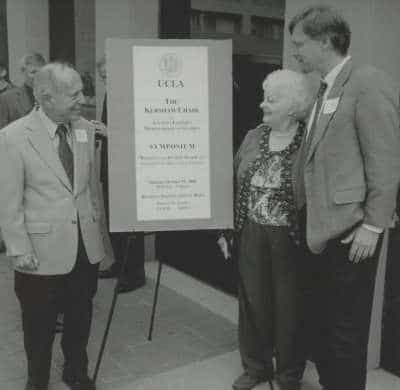
Reuben and Norma Kershaw with William Schniedewind
I am profoundly saddened by the passing of Norma Kershaw. Norma passed away on September 14, 2020, at her home in Mission Viejo. She was a visionary, benefactor, and my friend.
I met Norma just twenty-five years ago while giving a public lecture in Riverside, CA. I was a young scholar, but she was a force of nature even at 70 years old. Norma started her academic pursuits later in life, completing a B.A. at Queens College and then an M.A. in Art History and Archaeology from Columbia University at the age of 49. She worked on the excavation at Gezer with the Hebrew Union College and traveled extensively doing excavations and research in Israel, Cyprus, and Egypt. She taught at various colleges as a lecturer and won a distinguished teaching award from Hofstra University.
Her husband, Rube, and Norma retired to Mission Viejo in 1990, and she had a vision to build the study of archaeology and ancient Israel in Southern California. She was a founding member and avid supporter of various institutions like the Orange County chapters of the American Schools of Oriental Research, the Archaeological Institute of America, the Biblical Archaeology Society, and the Bowers Museum. She was there for every lecture at the Bowers Museum (where she donated the Kershaw Auditorium). Norma was always steering and advising the advancement of archaeology, Egyptology, and particularly the archaeology of Israel.
She was also an avid supporter of the Albright Institute of Archaeology in Jerusalem. Indeed, one of the things that I admired about Norma was the practicality of her vision. At the Albright, for example, she endowed the “Kershaw Garden,” a courtyard where scholars would meet every afternoon to discuss their work, enjoy some tea or beer, and develop lifelong relationships. And she wanted to make sure scholarship was accessible through sponsoring lectures at the Bowers or her synagogue.
I was honored in 2007 to be the first holder of the Kershaw Term Chair in Ancient Eastern Mediterranean Studies at UCLA. Norma also endowed a Chair in the Archaeology of Israel at UCSD (see above). These Chairs were a vehicle to support Norma’s vision for the archaeology of Israel. The UCLA Chair, in particular, supports graduate students, as well as the excavations at Jaffa, and now at Tel Dan.
Norma’s legacy will live on in her daughters, Janet and Barbara, as well as in all the people and institutions that she touched and supported. Her memory is indeed a blessing.
Andrew G. Vaughn, ASOR Executive Director
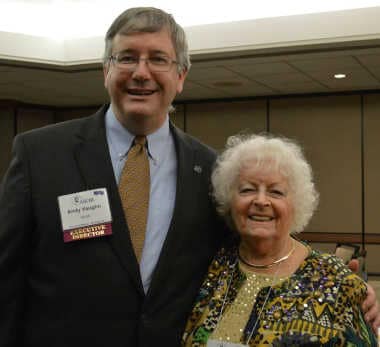
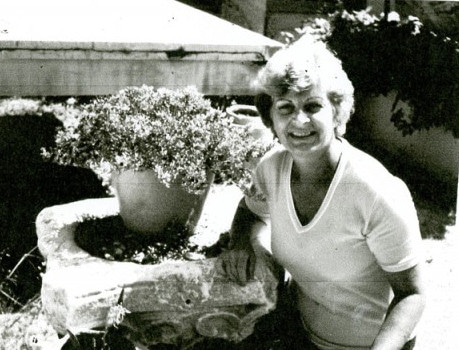
Norma at Tel Aphek, 1987
Norma became involved with ASOR more 50 years ago—she first visited the AIAR in 1968—yet it seems that she has always been a part of the ASOR family. Indeed, when then ASOR President Joe Seger presented Norma with the Richard J. Scheuer Medal (ASOR’s highest honor) in 1997, he observed as much. As noted above, Norma became involved in archaeology in her early 40s at Gezer, and she continued through the 80s at Salamis (Cyprus) and at Tel Aphek (see photo to the right above).
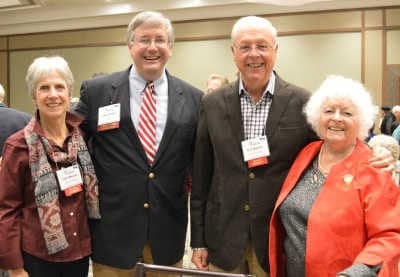
C. Meyers, A. Vaughn, E. Meyers, N. Kershaw
The first reference to Norma in the minutes of the ASOR Board (link) was in 1979, when she was elected as a trustee. The minutes and everyone’s memories reflect that Norma played a critical role in the governance and support of ASOR for the next 40 years. In 1983, she was instrumental in starting ASOR Tours, and she included a fundraising component in those trips (see the photo above from one of those trips to Syria). As recently as February of 2020, she counseled me on ways to reactivate and re-enliven ASOR Tours—unfortunately those plans are now on hold because of COVID-19.
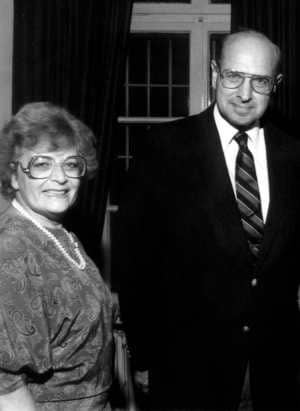
Norma and U.S. Ambassador Thomas Pickering at the Albright in Jerusalem
Later in the 80s, Norma became head of ASOR’s lecture series, and she yearned for ASOR to have a broader outreach program. More recently, she was an important adviser for the Friends of ASOR initiative. As ASOR was envisioning virtual outreach this past spring, Norma offered sage advice and asked excellent (but hard) questions. Her physical strength may have been slipping over the last year, but her mind and wit were as sharp as ever. Bill Schniedewind shared that even during a phone call the week before she passed, Norma was eager to participate in the discussion of ASOR’s name. She wanted to help us tell the story of “What is an ASOR?”
Concurrent with exhausting and important board service in many societies, Norma became an stimulating and motivating teacher in the Great Neck and New York areas. She was meticulous in her research, and she inspired countless other adults. She became something of an archaeological evangelist who converted many of the students in her classes into participants and supporters of archaeology and archaeological societies. Her love for the ancient world was magnetic.
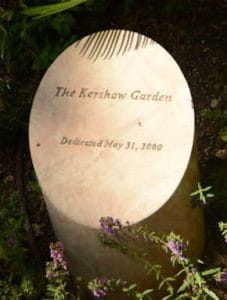
Norma’s philanthropic support extended even further. Norma knew that member communication was critical, and so she gave funds to support the newsletters of AIA and of ASOR. She also endowed a lecture series with the AIA.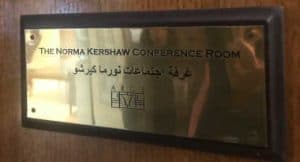
As stated in my beginning paragraph, I appreciated Norma’s friendship, encouragement, and sage counsel more than any type of financial support. She was an astute businesswoman and an accomplished scholar of the ancient world. We had numerous multi-day strategy sessions when I was a house guest in her home in Mission Viejo. She helped write development and outreach materials, and she continued to provide feedback and strategy through May of this year.
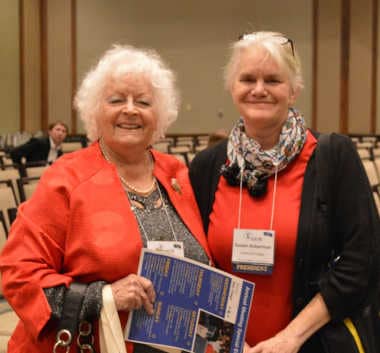
Norma Kershaw and Susan Ackerman
I will miss our frequent phone calls and the notes / letters that congratulated and encouraged. I knew that whenever a major announcement of a success went out electronically that I would receive a hand-written card or letter within 10-12 days. Even though only one of my children was able to meet Norma, she knew my children’s and parents’ names—she was truly interested to hear how they were doing.
I know that my experiences are shared by many. Norma was the same loyal friend to countless colleagues that she met during her involvement with AIA and ARCE chapters in New York and Orange County, or during her board service at the Bowers, AIA, and ASOR. She continued life-long relationships with students and colleagues from her teaching days. Her life was and will continue to be a blessing.
Janet, Barbara, and the entire Kershaw family: we offer our heartfelt condolences. In the (slightly adapted) words of Ruth (3:11), כי יודע כל–שער עמי כי אשת חיל היא “All the gate of my people know that she is a woman of worth.”
American Society of Overseas Research
The James F. Strange Center
209 Commerce Street
Alexandria, VA 22314
E-mail: info@asor.org
© 2025 ASOR
All rights reserved.
Images licensed under a Creative Commons Attribution-NonCommercial-ShareAlike 4.0 International License
